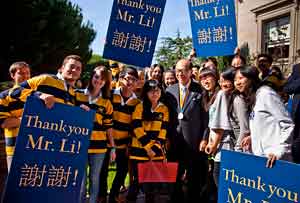Campus dedicates Li Ka Shing Center for Biomedical and Health Sciences, philanthropist receives Berkeley Medal
The Li Ka Shing Center for Biomedical and Health Sciences was dedicated on Friday, and international philanthropist and business leader Li Ka-shing, who made the lead gift of $40 million in 2005, was given the Berkeley Medal, the campus's highest honor.
October 21, 2011
Global entrepreneur and philanthropist Li Ka-shing visited UC Berkeley today (Friday, Oct. 21) to celebrate the new Li Ka Shing Center for Biomedical and Health Sciences that bears his name. Everywhere he went, dozens of students rushed to meet him, snapping his photo, waving, shaking his hand and holding signs saying “Thank you, Mr. Li!”
When it opens next semester, the center will be the nexus for a wide variety of multidisciplinary research at UC Berkeley that pursues ways to prevent the root causes of diseases such as cancer, Alzheimer’s, HIV and tuberculosis, rather than just the symptoms.

UC Berkeley students surrounded Li to express thanks as he departed campus.
On the new building’s esplanade, an 11 a.m. standing-room-only dedication ceremony drew more than 300 students, faculty, staff and guests. Chancellor Robert Birgeneau called it “a very happy event for our campus.” Remarks by Birgeneau, founding faculty director of the Li Ka Shing Center Robert Tjian, California Institute for Regenerative Medicine (CIRM) chair Jonathan Thomas and Li were followed by a ribbon-cutting ceremony and the presentation to Li of the Berkeley Medal, the campus’s highest honor.
Li, whose lead donation of $40 million in 2005 propelled support for the 200,000-square-foot facility, received the medal for his worldwide philanthropy and long-standing commitment to the advancement of education and the health care sciences.
“Mr. Li, a humanitarian leader and visionary, acts upon the values that emanate from his own life,” said Birgeneau in presenting the Berkeley Medal. “As a result of his own experience with poverty and illness in his youth, Mr. Li set out from an early age to help the sick and needy in Hong Kong, China and around the world.”

Touring the Li Ka Shing Center for Biomedical and Health Sciences, Li engaged in an experiment related to embryonic stem cells with Fong Yick-wah (right), a post-doctoral fellow. Looking on is Robert Tjian, professor of molecular and cell biology and founding faculty director of the center.
To date, the Li Ka Shing Foundation has granted more than $1.6 billion to charitable causes around the world. “I believe investments in high quality education are the best investments in improving the human condition,” said Li at the ceremony.
Addressing faculty researchers, he said, “In this new biomedical center, you are all accomplished scientists dedicated to exploring the frontiers of knowledge, and I am sure that aside from Berkeley you have a lot of offers to choose from. However, you have chosen to conduct your groundbreaking research here in a public institution with far fewer resources and lots of challenges to surmount. I salute your commitment and your contribution to society, and I know that your discoveries will bring significant changes to our world and positive benefits for all mankind.”
General contractor: McCarthy Builders
Project management: UC Berkeley Capital Projects
The building, the anchor for a quadrangle of research and teaching buildings dedicated to the biomedical and health sciences, will house more than 450 researchers and feature:
- Flexible, open labs shared by multiple investigators to facilitate collaboration
- Highly specialized facilities to house state-of-the-art instrumentation and containment areas for handling viruses and stem-cell cultures
- Teaching suites composed of laboratories, seminar rooms and a large lecture theater
- Clusters of faculty offices and student interaction suites
- The Henry H. Wheeler Jr. Brain Imaging Center, The Berkeley Stem Cell Center and The Henry Wheeler Center for Emerging and Neglected Diseases
- Sustainable environmental design features for energy efficiency
“We are indeed at the beginning of a new era of scientific research and innovation that promises major advances in the biological sciences that will profoundly impact human health,” said Tjian. “Knowledge of biology and how the body works is reaching a level of sophistication that could change the paradigm of health care. By treating and preventing diseases at the molecular level, a new generation of doctors, clinicians, and researchers will redefine how disease, aging, and life itself is understood and experienced.”

Li with Chancellor Robert J. Birgeneau. Li received the Berkeley Medal, the campus's highest honor, given to those "whose work or contributions to society illustrate the ideals of the university."
CIRM chair Thomas compared the magnitude of potential discoveries at the Li Ka Shing Center to that of the Salk vaccine on polio. “Great things will happen in this facility, and everything that happens here is a game changer,” he said.
The center “embodies what is so exciting about teaching and research at UC Berkeley and represents the campus’s core mission and commitment to playing a leading role to advance the frontiers of knowledge and education,” said Birgeneau.
Construction of the center also was made possible through a strong public-private partnership, including support from the California Institute for Regenerative Medicine, the Wayne and Gladys Valley Foundation and the Ann and Gordon Getty Foundation.
The dedication closed with a rousing appearance by the Straw Hat Band, which brought Li and Birgeneau off the stage to watch the performance up close. As he left the ceremony for a private luncheon at University House, Li delighted many of the students who surrounded him by speaking to them in Cantonese. That scene was repeated after Li left his luncheon and headed to a car waiting to take him to the airport, and students sent him off by holding thank you signs on a nearby staircase.